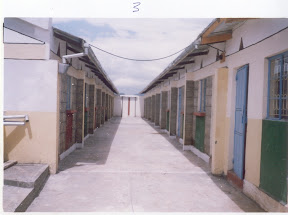Here is a trend that The Benin Epilogue has not yet addressed which has been growing steadily over the last several years. Africa's expatriates living abroad in the Diaspora are indirectly strengthening Africa's economies.
African migrants abroad are helping to bring about an economic boom in Africa in two ways:
Here are some key numbers, provided courtesy of Africa Recruit:
Here are some additional figures:
The following is a quote from the Kenya Diaspora Investment Forum that recently took place in London over the past weekend:
"Top African receiving countries are Egypt ($3.4bn), Morocco ($2.2bn), Nigeria (1.7bn), and Tunisia (0.8bn). In 2002 remittances to Nigeria ($2bn) accounted for 5% of the GDP playing a large part of the economy positively helping the balance of payments."
"The Government estimates that the Kenyan Diaspora remits close to $600 million every year to their families and for Investment purposes (Kelley 2005): Source Economic Commission for Africa Report on International Migration and Development: Implications for Africa September 2006."
Another interesting note on this trend is that these remittances are expected to continue growing over time. Of course this movement is not without challenges. There are several challenges to Diasporian Investment that I have heard on several occasions. The two that seem to be more major are the small numbers of "one-stop-shop" business start-up/investment centers in Africa and also the ease of obtaining information (or lack thereof) relative to making investment decisions.
However, over time I believe that these are obstacles that can and will be overcome. The sheer growth in numbers of Africa's Diasporian ( plus Foreign Investors) investing in Africa almost neccessitates this. Furthermore, these challenges and risks could be part of the reason that Africa's stock markets have outperformed some of the world's most bullish markets.
I believe that the continuance of this trend could bring about a full scale economic renaissance accross the African continent. Those are my thoughts, but we'd like to hear yours.
Also, do you have any experience in this area that you would like to share? Or is it something that you have considered-we'd like to know. Please feel free to post your comments below.
This link was provided by Joel but since it did not display properly, I have put it here
it is a page that discusses the reasons to invest in Kenya. Thank you very much Joel!
Of course, I love your comments. But, if you can't comment at this particular time- but would like to let us know that you were here; please sign and View my guestbook
Monday, December 11, 2006
Looking Towards the Diaspora for Investment
Tags:
Subscribe to:
Post Comments (Atom)








3 comments:
Kenyan investors look to Kampala for opportunities
--------------------------------------------------------------------------------
Last Updated on December 12, 2006, 12:00 am
By Kenneth Kwama
In its native country of Uganda, it is common knowledge that Stanbic Bank Uganda is offloading over one billion shares to the public in an Initial Public Offer (IPO).
The share-sale is also happening in Kenya, but in a contrasting style. Curiously lacking has been the usual advertising blitz that has accompanied past IPOs. The big adverts have been replaced by miniature notes with small arrows, strategically pinned in the corridors of the ground floor at Loita House, which houses the offices of Dyer & Blair, acting on behalf of its Ugandan affiliate, Dyer & Blair (Uganda) Limited, which is listed as a co-sponsoring broker in the offer.
"The IPO is Ush70 and we are providing an equivalent price of Sh2.85 per share," says Mohammed Hassan, Joint MD, Dyer & Blair Limited.
"This price factors in all costs of purchasing and transferring the Ugandan Shilling." Other brokerage firms can also get you into the game — CFC Financial Services Stockbroking Division, for example, is doing so for its clients — but the price may vary up to Sh3 a share.
Stanbic Bank Uganda is amongst the largest networked banks in Uganda. Application for shares opened November 24 and will close on December 22. Standard Bank of South Africa is the lead financial advisor.
Kenyans will be classified as foreign investors
With all the recent hoopla about cross-listing with the Uganda Securities Exchange (USE) and an eventual merger between the USE and the Nairobi Stock Exchange one might have expected a little more noise a lot earlier.
This it turns out may not even be necessary: the queues forming for the Stanbic offer are longer than those for the Mumias Sugar Company secondary sale. According to Mr Mohammed, a full merger will galvanise both the NSE and the USE.
"Demand for Kenyan stock will spread across to Uganda and vice-versa. This will push up demand and share prices," says Mr Mohammed.
Stanbic Bank Uganda hopes to raise at least Ksh2.9 billion from the Ugandan public and foreign investors to bolster its share capital. The offer is open, though Kenyans who buy in will be classified as foreign investors.
According to the prospectus, the minimum number of offer shares for which an application may be made is 1,000. Applications for greater than this minimum are to be made in multiples of 100 offer shares.
The firm will be hoping for full subscription of the shares and Dyer and Blair (Uganda) Limited, which is listed in the prospectus as a co-sponsoring broker, has enlisted the services of its local affiliate to sell shares to the Kenyan public.
20 per cent of the company on offer
According to Mr Mohammed, those purchasing from the Nairobi outlet are allowed to buy a minimum of 10,000 units at Ksh2.85 (Ush70) a share, denoting a minimum investment of Ksh28,500. Further shares have to be bought in 1000-unit batches.
"It is anticipated that the first dividend payable to shareholders following the listing will be the dividend for the financial year ending December 31, 2006," says a statement from the prospectus.
"The completed application form, together with the necessary cash or banker’s draft/cheque, drawn on a licensed bank, should be made payable in favour of Stanbic Bank Share Offer Account, and be submitted to any of the authorised selling agents," says the prospectus.
The shareholders, Stanbic Africa Holdings Limited (SAHL), and the Government of Uganda are selling 20 per cent of the company to the public, or slightly over one billion shares.
Stanbic Bank Uganda is a subsidiary of SAHL, which also runs Stanbic Bank Kenya. SAHL is owned by Standard Bank Group, which has vast operations in South Africa.
According to research notes from Nairobi-based affiliate company-Stanbic Investments, Stanbic Uganda commands 26 percent of Uganda’s market share.
"The bank plans to maintain this market share by increasing its customer service orientation and innovative products offering, which can use the broader Standard Bank Group as leverage and its larger asset base, which will enable it to be more aggressive in lending and wholesale banking," says info from the research paper titled Stanbic Uganda IPO.
Largest branch network
It says the bank also boasts a strong Return on Equity (ROE), put at 38 per cent last year. It estimates the average ROE for similar banks in Kenya to be 25 per cent.
Besides the merging of the NSE and USE into one market, another advantage expected to accrue to investors, is that Stanbic is the largest financial institution in Uganda and has the largest branch network. This makes it stand in good stead to reap from Uganda’s expected economic boom.
Uganda recently announced that it had struck oil in the Lake Albert Basin. It said that results from the two wells that have already been tested, shows that they have flows of 15,000 and 12,000 barrels a day, and could both yield up to one million barrels a day.
This could pump up to Ksh280 billion into the Ugandan economy by 2010, of which a substantial amount is expected to find its way into the various Ugandan banks as deposits.
The quietness with which the deal has been treated has, however, led to many speculations with some market sources saying Stanbic deliberately decided not to advertise the share offer so as not to attract additional conditionality from the Kenyan and Tanzanian CMAs.
"The CMA would have asked that they comply with several rules before selling shares here, which could have delayed the process. In order not to look like it was selling shares to the Kenyan public, Stanbic used Ugandan brokers who in turn liaised with Kenyan affiliates to sell the shares," says a source that requested anonymity.
Profitability dependent on prevailing economic conditions
But Mr Mohammed says that Ugandan shares that have so far been offered in the Kenyan market have been oversubscribed and they are expecting the Stanbic IPO to behave the same.
"The claims about adverts are not true. We are planning to advertise, but in the final stages of the IPO," he says.
According to Mr Mohammed, the price of Stanbic’s shares has more potential to shoot through the roof than that of Kenyan banks like Kenya Commercial Bank, Barclays and Stanchart because of its past Price Over Earning (POE), which he says are healthier.
"Based on empirical evidence, we expect 30 per cent returns in medium-term and a lot more in the long-term," says Mr Mohammed.
In addition to the usual risks inherent in share ownership such as the value of shares falling or rising, Mr Mohammed says that an investment in Stanbic Bank, just like investments in other financial institutions, carries with it business and company-specific risks.
For example, he says that the company’s profitability is largely dependent on the prevailing economic conditions in Uganda, which include currency and interest rate fluctuations that may expose it to currency and market risk.
Keeping subscribers to the minimum
"Currency risk stems from the volatility and fluctuations in exchange rates. The Ugandan market is very much like the Kenyan market and what happens in the local market also affects the Ugandan market. It is possible that declining interest rates, which are as a result of deliberate government policy, can also expose Stanbic to interest rate risk," says Mr Mohammed.
The result of this, he adds, will be a reduction of income from government securities and other investments held by Stanbic Bank. The style of the process may have wanted to keep subscribers to the minimum. Market sources say many local investors would especially buy into the Stanbic IPO to diversify their share portfolio as a way of reducing risk.
Stanbic Uganda made Ksh1.56 billion (Ush39 billion) profit after tax in the last financial year. The prospects next year look even better with the bank being projected to make over Ksh1.8 billion (Ush45billion) in next year.
According to the prospectus, an application has already been made to the Uganda Securities Exchange limited (USE) for the listing of over five billion shares in the main investment market segment and admission to the official list is expected to be effective from January 25 next year.
Thanks Joel for your comments
and recommendations.
For some reason the link from
your second comment
isnt posting properly.
I will add it to the link section
and to the end of the diaspora
investment section. Happy
Holidays and I hope to
hear back from you soon.
Thanks for sharing this with us...
Regards,
Business Transcription services
Post a Comment